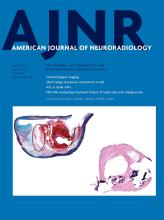Identifying the imaging biomarkers of normal pressure hydrocephalus (NPH) is critically important in the neuroimaging of cognitively impaired patients. For those with presumed diagnoses of treatment-resistant or -recalcitrant forms of dementia, this alternative etiology can alter prognosis.1 If the patient is responsive to shunting, the physical and mental benefit to an individual can be accompanied by re-engagement in social relationships. In addition, the increased participation in the activities of daily living can obviate the need for immersive long-term care and the resultant financial stress on families and communities.1,2
Given the potentially nonspecific clinical symptomatology of NPH, the neuroradiologist reviewing screening brain imaging may be the first—and only—physician to suggest its presence. Conversely, overlooking a narrowed callosal angle (CA) and other related findings can remove a treatable condition from differential considerations, depriving a patient of improved quality of life.
In this setting, the description and analysis of automated CA measurement by Borzage et al3 introduce a supplement to the armamentarium of radiologists evaluating neurodegenerative processes. Beyond discussing its technical basis, the authors reported that 12.4% of subjects within the Open Access Series of Imaging Studies and the Alzheimer Disease Neuroimaging Initiative data bases met the CA measurement criteria for NPH. This rate is surprisingly high, particularly among a group of individuals who underwent extensive screening and had passed stringent exclusion criteria. As the authors noted, these findings suggest that some study participants could have been treated with CSF diversion. Moreover, if accurate, the results alter the subject characteristics of numerous research studies, including those funded by a $3.1 billion federal expenditure in 2020.4
The authors appropriately suggested that additional analysis of the cohorts is needed. Specifically, the implication of a narrowed CA must be placed in the larger context of etiologic, clinical, and imaging features predictive of a response to shunting.1 For instance, does this 12.4% include volunteers or those with minimal symptomatology at baseline, explaining their ability to meet the inclusion criteria and preemptively negating consideration of surgical treatment? Do those with a narrowed CA have more advanced cognitive decline (with a relative lack of gait impairment) or demonstrate other comorbidities resulting in suboptimal risk-benefit for operative intervention?
Irrespective of the surgical candidacy of specific individuals, the results of Borzage et al3 demand a systems-based analysis of why MR imaging evidence of NPH was frequently missed. Does entry into research data bases necessitate formal neuroradiologic image interpretation? If not, perhaps such a review would facilitate individualized care while simultaneously ensuring the integrity of study cohorts. On the other hand, if a formal interpretation was performed, has the academic neuroradiology community effectively educated trainees on imaging of the cognitively impaired?
Assessing the callosal angle, among other findings, should be ingrained in the search pattern of dementia imaging. It should not be overlooked, to this degree, in even the busiest clinical practices. Promoting recognition of findings for a specific study indication is imperative to individualized patient care, even as automated interpretation tools play an increasingly welcome and important role in neuroimaging.
Footnotes
Disclosure forms provided by the authors are available with the full text and PDF of this article at www.ajnr.org.
- © 2022 by American Journal of Neuroradiology












